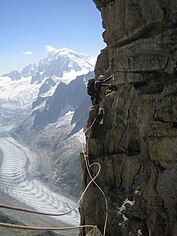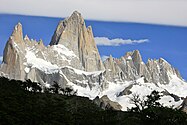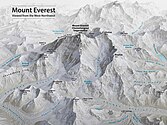Traverse (climbing)
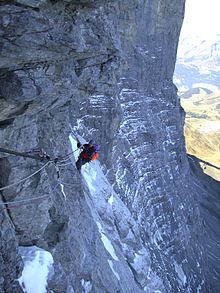
| Part of a series on |
| Climbing |
|---|
| Lists |
| Types of rock climbing |
| Types of mountaineering |
| Other types |
| Key actions |
| Key terms |
In climbing and mountaineering, a traverse is a section of a climbing route where the climber moves laterally (or horizontally), as opposed to in an upward direction. The term has broad application, and its use can range from describing a brief section of lateral movement on a pitch of a climbing route, to large multi-pitch climbing routes that almost entirely consist of lateral movement such as girdle traverses that span the entire rock face of a crag, to mountain traverses that span entire ridges connecting chains of mountain peaks.
Long traverses in rock climbing and alpine climbing may require additional climbing techniques (e.g. a pendulum or a tension traverse), and pieces of climbing equipment (e.g. ascenders) to manage the risks of the lead climber and/or the following climber falling far off the main route. Long traverses also place increased pressure on the abilities of the following climber than in a normal climb. Traversing is an even more regular feature in bouldering and is also a popular rock climbing training technique on indoor climbing walls.
Notable traverses include the 4,500-metre El Capitan Girdle Traverse on El Capitan, the world's longest rock climbing route;[a] the Hinterstoisser traverse on the Eiger, which was the key to the famous 1938 Heckmair Route; and the Fitz Roy traverses (both directions) of the Cerro Chaltén Group, which are considered some of the hardest 'mountain traverses' ever completed. Climbers consider the 'Everest-Lhotse traverse', and the even harder 'Everest-Lhotse-Nuptse traverse', as some of the unfinished "holy grails" of mountaineering.
In rock climbing

Some rock climbing routes have traverse sections that move horizontally for a period. There are many reasons for this including avoiding or side-stepping challenges whose grade is too hard (e.g. a major roof or a very 'blank' section of rock), or trying to follow a crack climbing route where a set of cracks run out and the climbers must move horizontally for a period to find the next set of cracks to continue upward. The term 'direttissima' (or 'direct') is used for refinements of climbing routes that dispense with traverses and rise vertically upward in the straightest possible line from the ground to the top.[1]
Traversing uses specific climbing techniques such as 'crimping', 'side-pulls', 'laybacking', 'stemming', and 'cross-throughs' (the limbs are crossed so the moves are longer and fluid).[1][2] On some big wall climbing traverses, such as King Swing on The Nose on El Capitan, the traverse cannot be climbed and is instead crossed using a 'pendulum' or 'tension traverse' rope technique.[3] If more than one person is climbing, traversing requires the following climber to have stronger technical abilities, since they will not be essentially top roped when belayed by the lead climber as in a non-traverse route.[4][5]
Long traverses require specific pieces of equipment and protection to handle the resulting 'pendulum falls' where a fallen climber (both the lead and following climber) can end up so far off-route that climbing back up is impossible and they will have to jumar back up to the route using ascenders. In addition, the lead climber will place strong protection both before and after a difficult (or crux) move on a traverse to allow the following climber to remove the first piece of protection before making the difficult move while still having protection against a more significant 'pendulum fall' from the protection that was placed just after the move.[4][6]
Routes with traverses can be found at most climbing areas and some are famous for their 'girdle traverse', which are very long traverse routes that horizontally span the entire rock climbing area or crag.[7] Notable girdle traverses include The Great Wall of China (3,000 metres, 67-pitches, 5.9 R) on the Shawangunks in New York State, the Stanage Traverse (circa 5,000 metres but broken up in places, E5 6b) at Stanage Edge in England, and the El Capitan Girdle Traverse (4,500 metres, 75-pitches, 5.10 A4) on El Capitan in Yosemite,[8][9] which was the world's largest continuous climbing pitch as of 2024.[a][11]
In bouldering
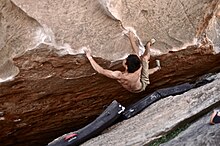
Traversing is an even more regular feature of bouldering, where there is less focus on moving exclusively upwards and many bouldering routes will involve a quasi-traverse of diagonal upward movements (e.g. Dreamtime), or at the more extreme end, traverses across a low roof (e.g. The Wheel of Life).[9] Long boulder traverses have been described as a "distinct sub-discipline in climbing",[9] and in the famous Fontainebleau bouldering area, specific amendments are made to the Font grade to allow for the increased stamina requirements of traverses (e.g. while a bouldering Font 9A is equivalent to an American V grade of V17, a long boulder traverse of 9A may only have the technical challenge of an American V13 grade).[9]
In mountaineering
As in rock climbing, mountaineering also uses the term 'traverse' for sections of routes that require horizontal or lateral movement. Traverses are a particular feature in long alpine climbing routes, where—just like in big wall rock climbing—traverses are used to bypass unclimbable sections (i.e. where a direttissima is not yet possible and the climbers need to move laterally to access climbable features).[1] One of the most famous examples is the Hinterstoisser traverse, a critical 'tension traverse' on the 1938 Heckmair Route (ED2, V−, A0, 60° snow) on the north face of the Eiger.[12]
In mountaineering, the term is also used in a broader sense to describe large mountain routes that follow high ridges that connect several mountain peaks. A classic example of a 'mountain traverse' is Peter Croft's Evolution Traverse (VI, 5.9, 8-miles, over 3,000 metres of cumulative elevation gain CAG) in the Evolution Basin of the Sierra Nevada, which follows a rocky ridge that crosses nine peaks of over 13,000 feet in elevation, and takes circa 1–2 days to complete.[13] Other examples of notable 'mountain traverses' include the Cullin Ridge Traverse in Britain.[14]
The CAG is a key metric of 'mountain traverses' that gives the total amount of vertical climbing required (i.e. a flat ridge across a chain of peaks will have a zero gain outside of the gain to ascend the ridge). The greater the CAG, the less the route is like a traverse and more akin to an enchainment of peaks. Where a mountain traverse does not follow a well-defined ridge, it is also more likely to be an enchainment. A notable example of the distinction involves Everest and Lhotse: the 'Everest-Lhotse enchainment', was first completed in 2011 by American guide Michael Horst,[15] but the harder 'Everest-Lhotse traverse' (which follows the crest of the sharp rocky ridge connecting the two peaks) remains an unsolved problem in mountaineering.[16][17]
Some of the hardest 'mountaineering traverses' include the 5 km traverse of the seven main peaks of the Cerro Chaltén Group, which is called The Fitz Roy Traverse if done north-to-south,[18] and the Moonwalk Traverse if done south-to-north,[19] and has over 4,000 metres of CAG.[20] The traverse of the Mazeno Ridge, which is the longest continuous ridge of any of the eight thousander mountains, is also notable.[21][22] The climbers who made the first ascents of these extreme 'mountain traverse' routes won the Piolets d'Or, which is the highest award in mountaineering. The unclimbed 'Everest-Lhotse traverse' and the even harder 'Everest-Lhotse-Nuptse traverse', are described by some as the outstanding "holy grails" of mountaineering.[16][17]
In training
In climbing, traversing along a climbing wall is often performed as a warm-up exercise, and to also build finger strength and stamina.[23] Standard variations include traversing using only side-pulls, or only just two fingers, or only cross-throughs.[24][25]
In 1968, a novice British climber named John Syrett, began training obsessively by continually traversing on a low recently built climbing wall in a long corridor of Leeds University—it was one of the first climbing walls ever constructed.[26] On one of his first ventures to outdoor rock climbing, Syrett onsighted Wall of Horrors, which at E3 6a was one of the most intimidating traditional climbing routes in Britain.[23] Several other British climbers would follow Syrett's example so that traversing on small holds (or even on brick walls), became a staple training technique for climbers.[23][27]
See also
Notes
- ^ a b The world's largest vertical climbing route is considered to be the big wall climbing route, The Grande Voyage (1,340 metres, VII 5.10 A4+ WI3), which is on the Great Trango Tower in the Himalayas.[10]
References
- ^ a b c The Mountaineers (2018). Mountaineering: The Freedom of the Hills (9th ed.). Quiller Publishing. pp. 234–236. ISBN 978-1846892622.
- ^ Matt Burbach (2005), Gym Climbing, The Mountaineers Books, pp. 90–91, ISBN 978-0-89886-742-8
- ^ Chelton, Neil (2019). "Pendulums and Tension Traverses". The Trad Climber's Guide To Problem Solving. VDiff Climbing. ISBN 9781795602204. Retrieved 15 May 2024.
- ^ a b Peter, Libby (24 May 2010). "Happy Traversing for Leader and Second". UKClimbing. Retrieved 15 May 2024.
- ^ The Mountaineers (2018). Mountaineering: The Freedom of the Hills (9th ed.). Quiller Publishing. pp. 306–307. ISBN 978-1846892622.
- ^ The Mountaineers (2018). Mountaineering: The Freedom of the Hills (9th ed.). Quiller Publishing. pp. 268–269. ISBN 978-1846892622.
- ^ "Girdle Traverse". Collins English Dictionary. 2024. Retrieved 15 May 2024.
mountaineering: a climb that consists of a complete traverse of a face or crag
- ^ Leavy, Michael (1 July 2022). "Why Go Up When You Could Go Sideways? Here Are 4 Massive Girdle Traverses". Climbing. Retrieved 15 May 2024.
- ^ a b c d Corrigan, Kevin (3 January 2023). "An Ode to Traverses". Climbing. Retrieved 15 May 2024.
- ^ Lucas, James (16 August 2016). "Great Trango Tower: The Biggest Big Wall". Climbing. Retrieved 18 May 2023.
- ^ "Longest climbing route". Guinness World Records. 2024. Retrieved 15 May 2024.
- ^ "Eiger speed record by Dani Arnold". PlanetMountain. 24 April 2011. Retrieved 10 May 2023.
- ^ Samet, Matt (19 September 2019). "Classic Routes: Evolution Traverse (VI 5.9), Sierra Nevada, California". Climbing. Retrieved 15 May 2024.
- ^ Lambert, Eric (7 May 2008). "New Cuillin Traverse record". Alpinist. Retrieved 15 May 2024.
The [traverse] has long been considered one of Britain's greatest alpine challenges
- ^ Schwartz, Dan (19 March 2011). "Everest and Lhotse in 21 Hours". Alpinist. Retrieved 15 May 2024.
- ^ a b Leavy, Michael (2 March 2022). "Are These Two Men Going After the Holy Grail of Himalayan Climbing? The Everest-Lhotse traverse". Climbing. Retrieved 15 May 2024.
- ^ a b Benevides, Angela (23 May 2023). "David Goettler Summits Everest No-O2; Plus, What Exactly is the Everest-Lhotse Traverse?". ExplorersWeb. Retrieved 15 May 2024.
- ^ Franz, Derek (15 February 2021). "Interview with Sean Villanueva O'Driscoll about his solo traverse of Patagonia's Fitz Roy massif (the Moonwalk Traverse)". Alpinist. Retrieved 15 May 2024.
- ^ "The Greatest Alpine Climb Ever Done?". Gripped Magazine. 19 February 2021. Retrieved 15 May 2024.
- ^ Sterling, Sarah (14 February 2021). "The most impressive traverse ever completed?". British Mountaineering Council. Retrieved 15 May 2024.
- ^ Bacon, Sean (31 July 2012). "Brits Summit Nanga Parbat via Mazeno Ridge". Climbing. Retrieved 15 May 2024.
One of the greatest remaining challenges in the Himalayas, the 13-kilometer Mazeno Ridge traverse crosses eight peaks before reaching the 8,126-meter summit of Nanga Parbat, the ninth highest mountain on Earth
- ^ Griffin, Lindsay (2013). "Nanga Parbat (8,125m), Mazeno Ridge history". American Alpine Journal. 55 (87): 282. Retrieved 15 May 2024.
- ^ a b c Ward, Mick (26 January 2011). "Wall Warriors! A history of training for climbing". Retrieved 16 May 2024.
- ^ Horst, Eric (July 2016). Training for Climbing: The Definitive Guide to Improving Your Performance. Falcon Guides. p. 75. ISBN 978-1493017614.
- ^ Elison, Julie (20 June 2023). "Summer Slump? These 13 On-the-wall Workouts Will Prepare You for Sending Season". Climbing. Retrieved 15 May 2024.
- ^ Ward, Mick (30 January 2018). "How the Leeds Wall Changed Climbing History". UKClimbing. Retrieved 26 November 2022.
- ^ Osius, Alison (18 June 2024). "A Short History of the Climbing Gym". Climbing. Retrieved 28 September 2024.
Further reading
- The Mountaineers (2018). Mountaineering: The Freedom of the Hills (9th ed.). Quiller Publishing. ISBN 978-1846892622.
External links
- The Traverse | Attempting The World's Most Famous Ridgeline, EpicTV (2023)


